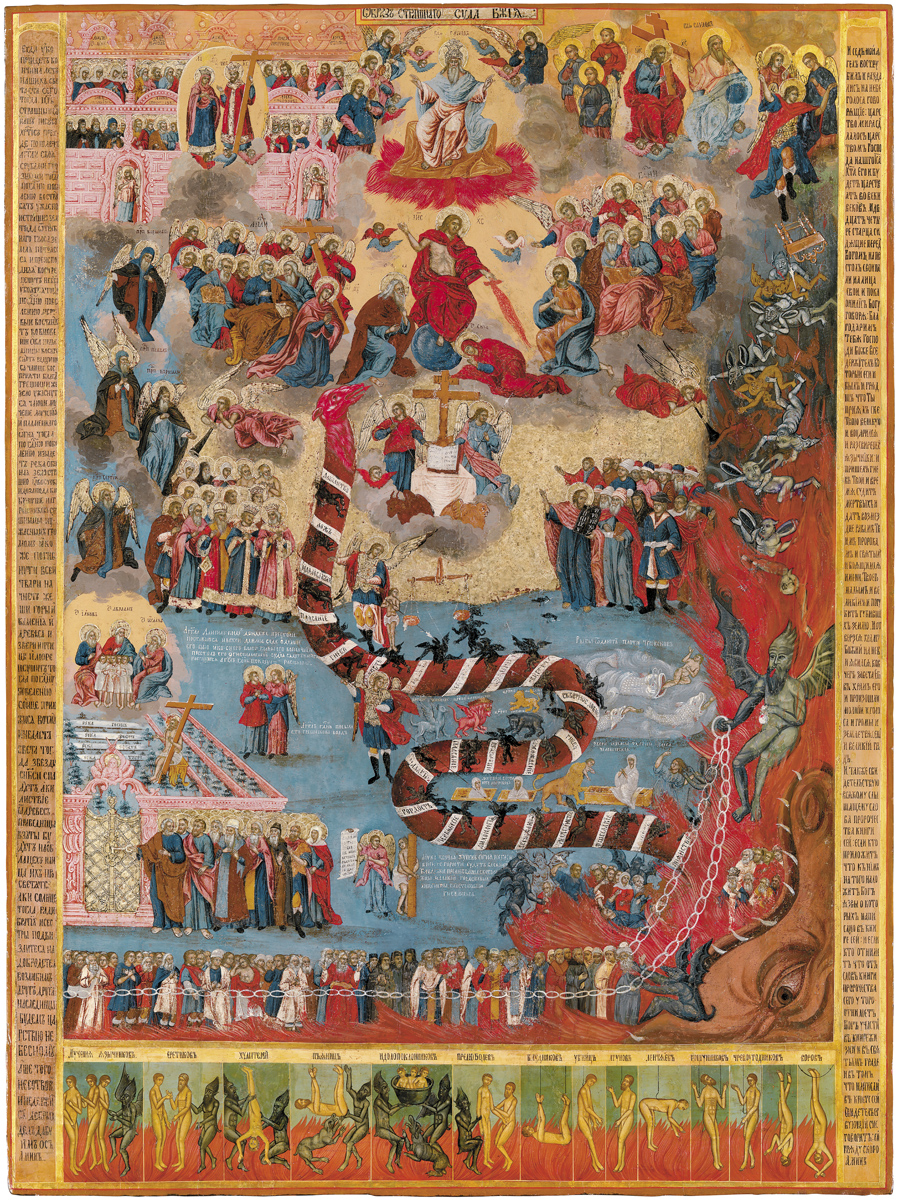MacDougall's Russian Art Auctions 1-2 Dec 2010
1 December 2010

623. AN IMPORTANT ICON OF THE LAST JUDGEMENT
VLADIMIR REGION, 19TH CENTURY
140 by 104 cm
90,000-120,000 GBP
Related Literature: For similar icons, see Auction Catalogue, Icons of the Orthodox World, MacDougall’s, June 2009, Lot 177, p. 114
The theme of the Last Judgement is connected with the Apocalypse of John the Divine, the Prophet Daniel, the life of Saint Basil the New and the ‘Theotokos walking through the torments of hell’. In the Orthodox Church, the Last Judgement is commemorated on the Sunday before Shrovetide. In the reign of Peter I, this service was celebrated and monumental depictions of the Last Judgement were created mainly for Old Believers.
The Last Judgment as a detailed composition has its origins in the 16th century. Traditionally, a painting of the Last Judgement is divided into two parts by the image of Christ the Judge at the centre. On His right are scenes of Paradise, and on his left — hell. In the central part of the icon groups of the Righteous and Sinners are moving towards Divine Judgement. Lower down is the Prophet Daniel’s vision of four kingdoms: the Persian, Babylonian, Hellenic and that of the Antichrist. Flying angels drive sinners into the fiery Gehenna.
Icons of the Last Judgement belong to the eschatological type of artefact intended to edify. This icon retains the tradition of a throne in the centre with angels standing either side supporting the Gospels. Precisely in the centre (a 17th century feature) the vertical axis is established with Christ, the Mother of God, Adam and Eve and the Ancient of Days on His throne surrounded by angels. Further traditional aspects are depictions of the Heavenly Jerusalem, the ‘New Testament Trinity’, the twelve apostles with angels, groups of the Righteous led by the Apostle Peter, who opens the ‘golden’ gates of paradise, the ‘Bosom of Abraham’, Earth and Water giving up the dead, and the very serpent itself. Despite the fact that the separate last tier, with its graphic illustrations of torments for specific sins, appears mainly in later artefacts, it was known in the 16th century. A peculiarity of the iconography of our icon is the absence of St. John the Forerunner, who as a rule is depicted in front of Christ. Here, an apostle is leading the group of solemnly seated apostles on the right.
In comparison with other images of the Last Judgement, this work is unusual — it does not have a strictly structured set of horizontal scenes, and the characters, despite being in groups, seem to exist in the same flowing entity. This effect is achieved not only by the animation of the images, but also in the way they are arranged in the available space. The heavily populated upper portion contrasts with the more rarefied lower field: this divergence is further emphasised by the contrasting bright and dull colours.
The colours used in this icon also serve a conceptual purpose. For example, the pink hue used by the icon painter is associated with the Heavenly City, yellow with God and gold with the Divine Principle.
The workshop this icon came from was evidently orientated towards producing metropolitan work. It is distinguished by its well-crafted composition, the simplicity of its images, its painterliness, the brightness and variety of its colours and the use of silver instead of gold leaf. All this speaks of an individual approach in bringing to fruition a design concept of high artistic merit and its dimensions imply it was painted for a major church.
The complexity of the composition, the combination of colours and the portrayal of some five hundred different persons without a single face being repeated is distinct from the majority of Last Judgement images of the time.
Notes on symbols:
* Indicates 5% Import Duty Charge applies.
Ω Indicates 20% Import Duty Charge applies.
§ Indicates Artist's Resale Right applies.
† Indicates Standard VAT scheme applies, and the rate of 20% VAT will be charged on both hammer price and premium.